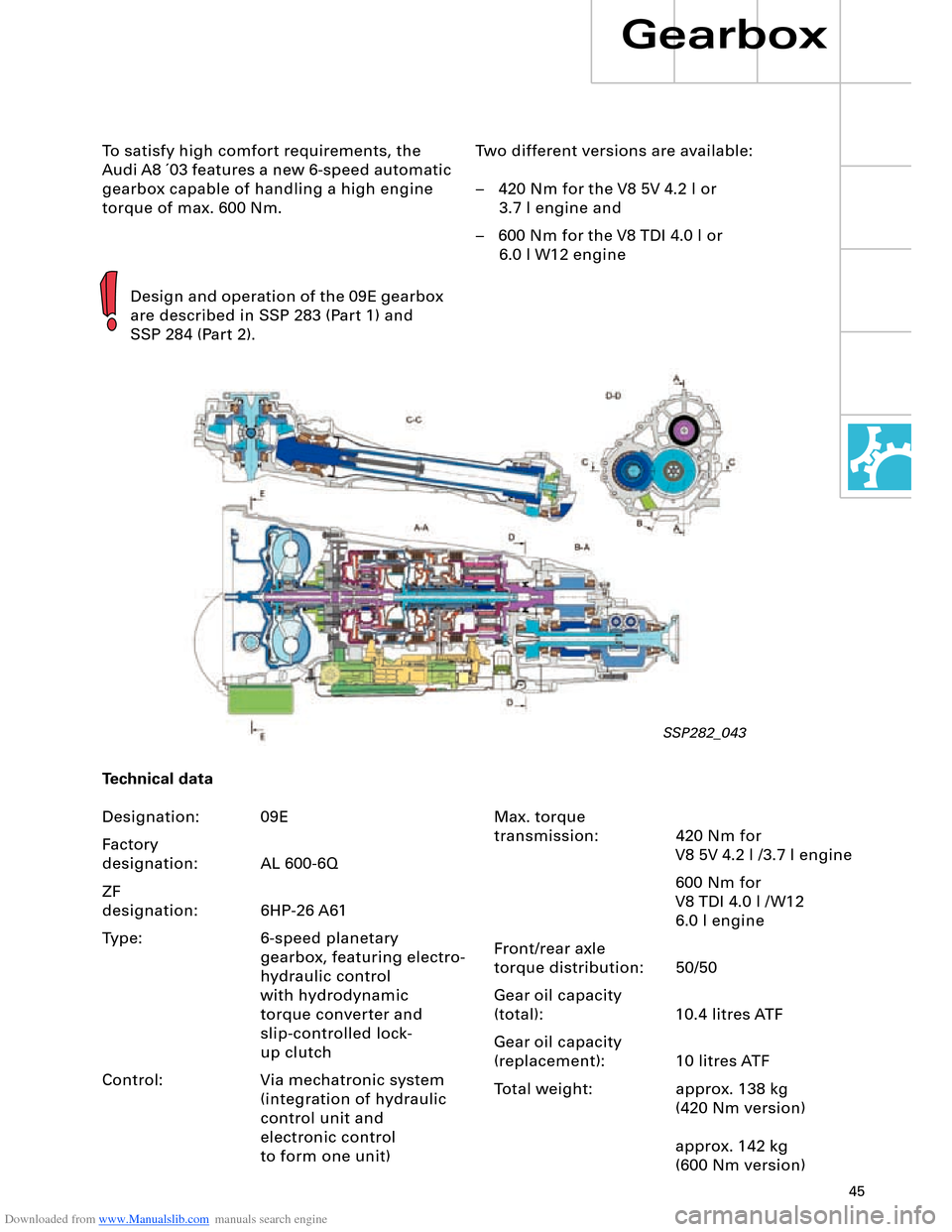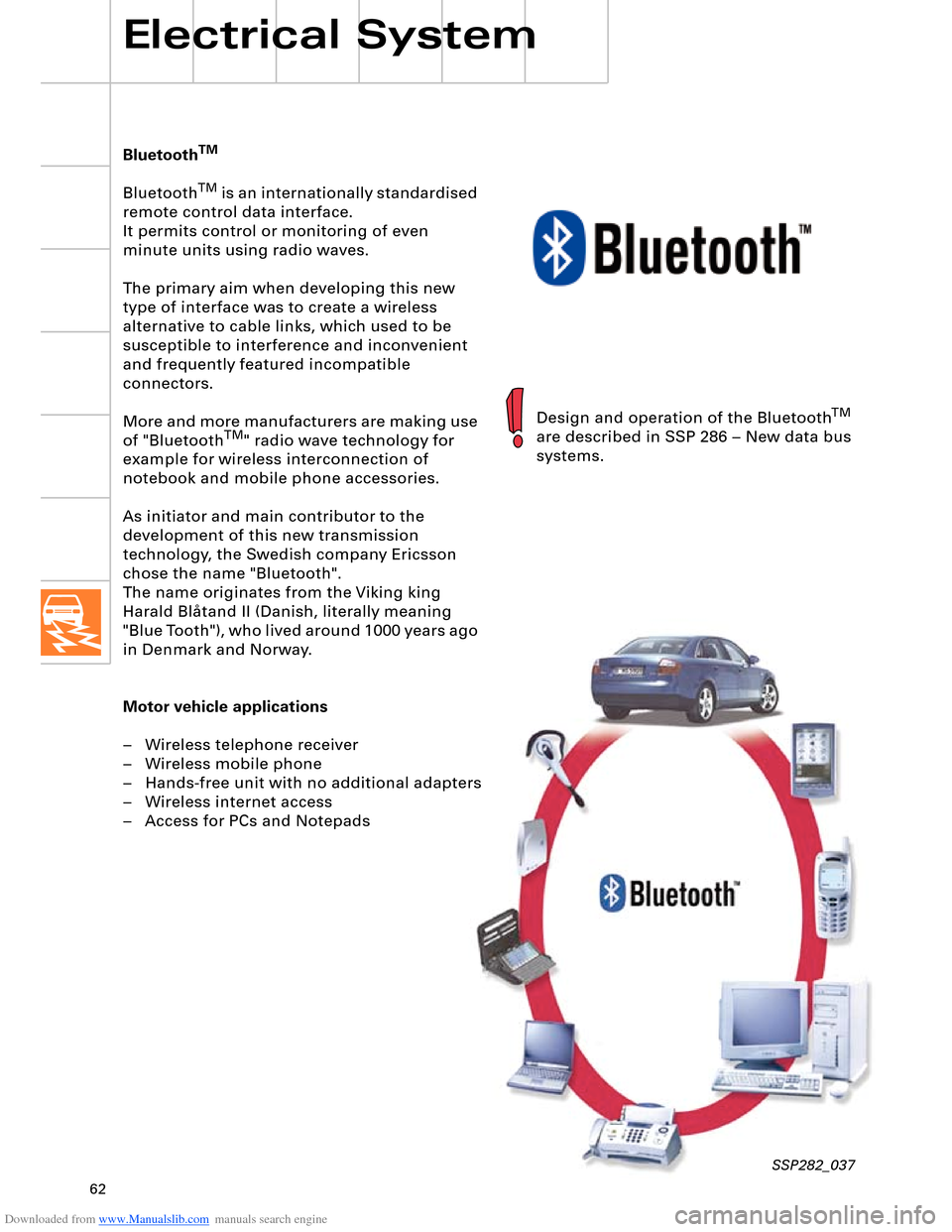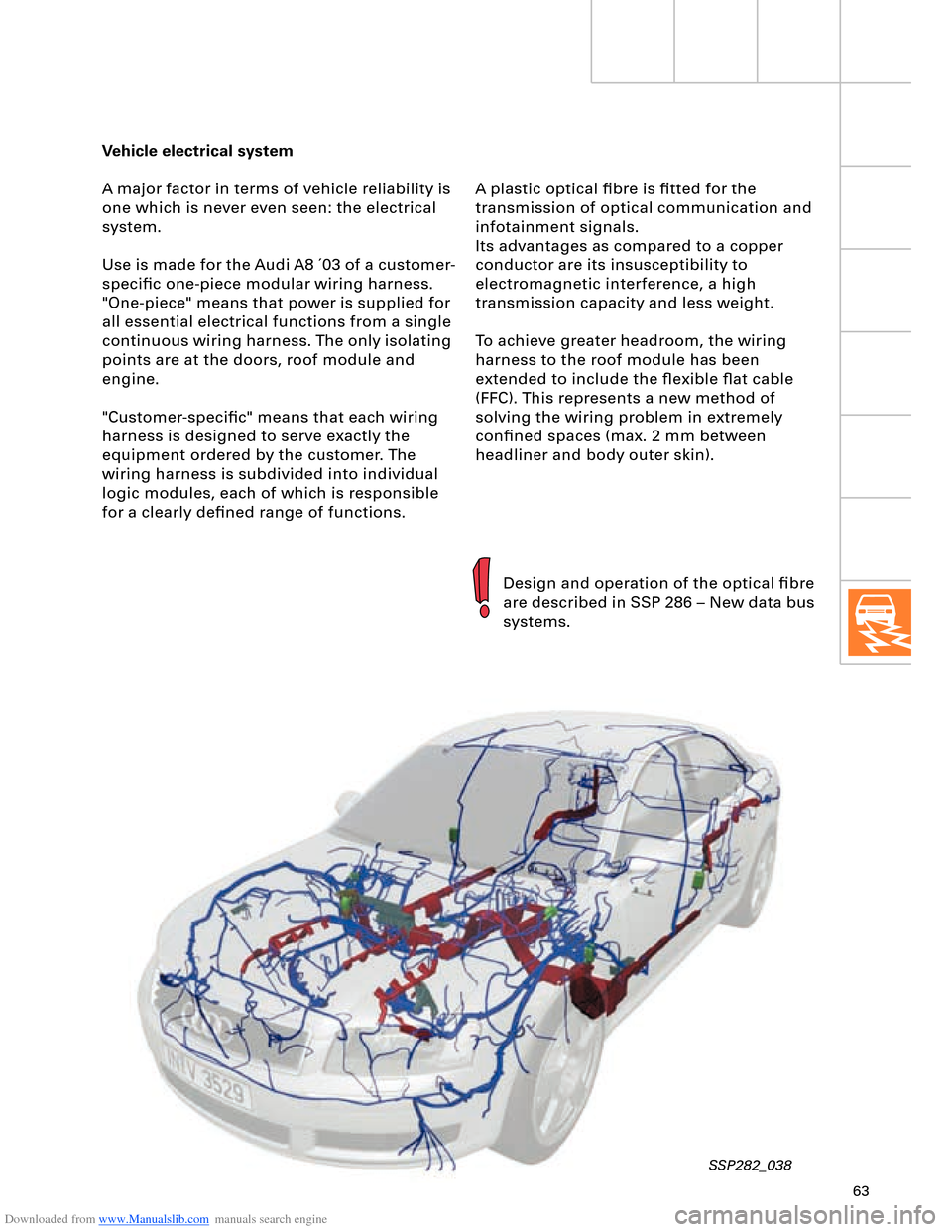transmission AUDI A8 2003 D3 / 2.G Technical Features Manual
[x] Cancel search | Manufacturer: AUDI, Model Year: 2003, Model line: A8, Model: AUDI A8 2003 D3 / 2.GPages: 96, PDF Size: 5.51 MB
Page 45 of 96

Downloaded from www.Manualslib.com manuals search engine 45
Two different versions are available:
– 420 Nm for the V8 5V 4.2 l or
3.7 l engine and
– 600 Nm for the V8 TDI 4.0 l or
6.0 l W12 engine To satisfy high comfort requirements, the
Audi A8 ´03 features a new 6-speed automatic
gearbox capable of handling a high engine
torque of max. 600 Nm.
Gearbox
Design and operation of the 09E gearbox
are described in SSP 283 (Part 1) and
SSP 284 (Part 2).
SSP282_043
Technical data
Designation: 09E
Factory
designation: AL 600-6Q
ZF
designation: 6HP-26 A61
Type: 6-speed planetary
gearbox, featuring electro-
hydraulic control
with hydrodynamic
torque converter and
slip-controlled lock-
up clutch
Control: Via mechatronic system
(integration of hydraulic
control unit and
electronic control
to form one unit)Max. torque
transmission: 420 Nm for
V8 5V 4.2 l /3.7 l engine
600 Nm for
V8 TDI 4.0 l /W12
6.0 l engine
Front/rear axle
torque distribution: 50/50
Gear oil capacity
(total): 10.4 litres ATF
Gear oil capacity
(replacement): 10 litres ATF
Total weight: approx. 138 kg
(420 Nm version)
approx. 142 kg
(600 Nm version)
Page 46 of 96

Downloaded from www.Manualslib.com manuals search engine 46
Highlights of automatic gearbox 09E
The 6-speed planetary gearbox is based on the
Lepelletier principle.
This concept is characterised by harmonic
gear ratio steps and the implementation of six
forward gears and one reverse gear with only
five selector elements.
Use is made in this gearbox of a new internal
gear oil pump featuring a lower delivery
volume and reduced leakage.
In addition, it was possible to achieve
optimisation of the oil supply with lower
leakage rates in the hydraulic control system.
The "stationary disconnection" function
reduces engine output when the vehicle is
stopped with a gear engaged by interrupting
power transmission.
A particularly noteworthy feature of the 09E
automatic gearbox is the relocation of the
front-axle differential (flange shaft) to in front
of the torque converter.
The distance between flange shaft and engine
flange is now only 61 mm (01L = 164 mm).
Gearbox
SSP282_044
SSP282_045
(AL 600-6Q)
Page 62 of 96

Downloaded from www.Manualslib.com manuals search engine 62
Electrical System
BluetoothTM
BluetoothTM is an internationally standardised
remote control data interface.
It permits control or monitoring of even
minute units using radio waves.
The primary aim when developing this new
type of interface was to create a wireless
alternative to cable links, which used to be
susceptible to interference and inconvenient
and frequently featured incompatible
connectors.
More and more manufacturers are making use
of "Bluetooth
TM" radio wave technology for
example for wireless interconnection of
notebook and mobile phone accessories.
As initiator and main contributor to the
development of this new transmission
technology, the Swedish company Ericsson
chose the name "Bluetooth".
The name originates from the Viking king
Harald Blåtand II (Danish, literally meaning
"Blue Tooth"), who lived around 1000 years ago
in Denmark and Norway.
Motor vehicle applications
– Wireless telephone receiver
– Wireless mobile phone
– Hands-free unit with no additional adapters
– Wireless internet access
– Access for PCs and Notepads
SSP282_037
Design and operation of the BluetoothTM
are described in SSP 286 – New data bus
systems.
Page 63 of 96

Downloaded from www.Manualslib.com manuals search engine 63
Vehicle electrical system
A major factor in terms of vehicle reliability is
one which is never even seen: the electrical
system.
Use is made for the Audi A8 ´03 of a customer-
specific one-piece modular wiring harness.
"One-piece" means that power is supplied for
all essential electrical functions from a single
continuous wiring harness. The only isolating
points are at the doors, roof module and
engine.
"Customer-specific" means that each wiring
harness is designed to serve exactly the
equipment ordered by the customer. The
wiring harness is subdivided into individual
logic modules, each of which is responsible
for a clearly defined range of functions.
SSP282_038
Design and operation of the optical fibre
are described in SSP 286 – New data bus
systems. A plastic optical fibre is fitted for the
transmission of optical communication and
infotainment signals.
Its advantages as compared to a copper
conductor are its insusceptibility to
electromagnetic interference, a high
transmission capacity and less weight.
To achieve greater headroom, the wiring
harness to the roof module has been
extended to include the flexible flat cable
(FFC). This represents a new method of
solving the wiring problem in extremely
confined spaces (max. 2 mm between
headliner and body outer skin).